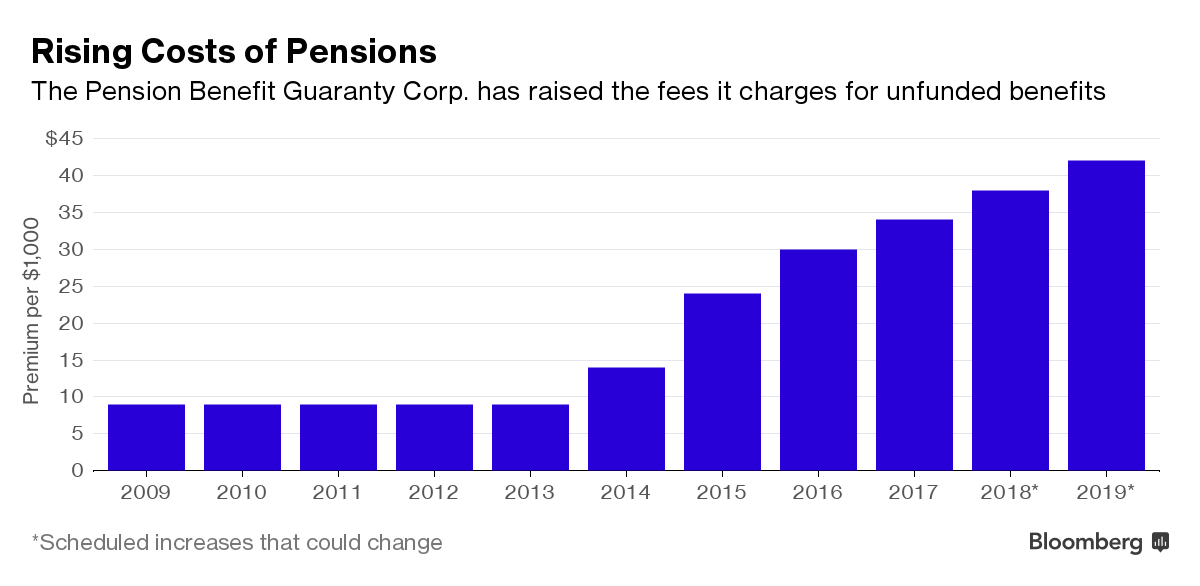Employers saddled with swelling pension obligations and higher government fees on those liabilities are finding some relief in the corporate debt market.
Delta Air Lines, Verizon Communications and FedEx have issued more than $14 billion in bonds this year in which some proceeds were flagged for bolstering their retirement programs, according to data compiled by Bloomberg. Last year, General Motors did the same, and International Paper had a debt sale as part of a plan to fund expenses including pension costs.
Companies are looking to avoid the higher premiums required on liabilities by the Pension Benefit Guaranty Corp., a government agency that acts as a backstop when plans fail. The cost per thousand dollars of unfunded benefits has more than tripled in recent years, making it more attractive for employers to shift risk to bondholders.
“The PBGC premiums are a constant and nagging concern,” Richard McEvoy, the U.S. leader of the financial strategy group at consulting firm Mercer, said in an interview. Issuing bonds to bolster pensions “is a very clearly good trade.”
In 2016, companies voluntarily added about $40 billion to pensions, the first year since 2012 that the figure increased, according to an estimate by Goldman Sachs Group Inc. based on an analysis of the S&P 500 index. Still, corporate America had a shortfall of more than $300 billion on pensions at the end of December, according to a review of 100 large plans by Milliman, the provider of actuarial products.
By filling the gaps, companies can also make it easier to transfer obligations to an insurer looking to add assets under management. Prudential Financial, MetLife and Massachusetts Mutual Life Insurance Co. have been winning deals in the growing pension risk transfer market. Athene Holding, the annuity seller with ties to Apollo Global Management, is also seeking such transactions. There were more than $13 billion of pension buyout deals in 2016, according to industry group Limra, and the volume of transactions has been climbing in recent years.
Companies may also use debt issuance as a path toward offering lump-sum payments to retirees, or even to allocate assets into more stable investments. Mercer said it may make sense to act soon to fill funding gaps, because potential changes in tax law under President Donald Trump could erode some of the advantages.
Using debt is more attractive for high-grade borrowers who benefit from lower costs in the corporate bond market. Delta, which carries the lowest investment-grade credit rating from Moody's Investors Service, was able to issue five-year debt at a coupon of 3.625%. Verizon, rated two steps higher, priced five-year notes at 3.125%. By the end of the decade, companies will likely be paying the PBGC more than 4% on the underfunded portions of pension plans.
'Attractive Economics'
“A key economic benefit of funding the pension plan with debt is reducing the unfunded liability, which in turn reduces the rising PBGC variable-rate premiums we have to pay,” Bob Varettoni, a spokesman for Verizon, said by email. GM's Tom Henderson said that reducing pension risks with bond proceeds offered “moderately attractive economics.”
After years of low bond yields sapped returns on assets, pension managers have learned not to count on a quick return to historical averages, or to get too excited about the rise in rates in the latter part of 2016. The funded status of pensions held by companies in the S&P 1500 Index was just 82% at the end of 2016, the same as 12 months earlier, according to a report by Mercer.
“Rising rates alone are not going to close the gap. Some amount of funding has to happen,” said Ajay Khorana, global head of Citigroup's financial strategy and solutions group. “Money is flowing into fixed income, and companies will take advantage of it.”
Pensions were stung in the financial crisis as markets plunged. After that, near-record low interest added to the pain as the funds were stuck with lower-than-expected returns on bonds. Verizon still had more than $20 billion in projected remaining obligations at the end of 2016, and its plan was underfunded by about $6.4 billion.
“People have just become tired of the pension plan being such a significant issue to their overall corporation,” said Greg Calnon, managing director at Goldman Sachs Asset Management.

Bloomberg News
Complete your profile to continue reading and get FREE access to Treasury & Risk, part of your ALM digital membership.
Your access to unlimited Treasury & Risk content isn’t changing.
Once you are an ALM digital member, you’ll receive:
- Thought leadership on regulatory changes, economic trends, corporate success stories, and tactical solutions for treasurers, CFOs, risk managers, controllers, and other finance professionals
- Informative weekly newsletter featuring news, analysis, real-world case studies, and other critical content
- Educational webcasts, white papers, and ebooks from industry thought leaders
- Critical coverage of the employee benefits and financial advisory markets on our other ALM sites, PropertyCasualty360 and ThinkAdvisor
Already have an account? Sign In Now
*May exclude premium content© 2025 ALM Global, LLC, All Rights Reserved. Request academic re-use from www.copyright.com. All other uses, submit a request to [email protected]. For more information visit Asset & Logo Licensing.





